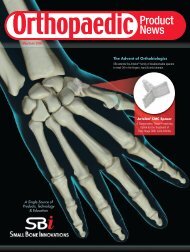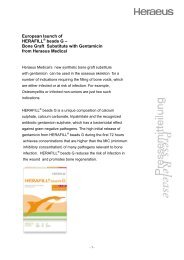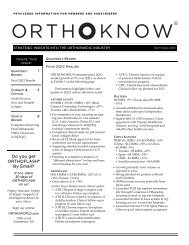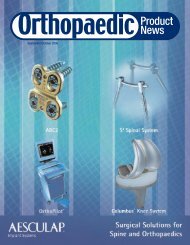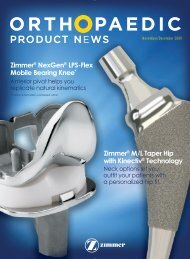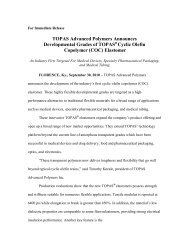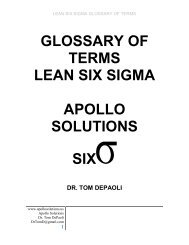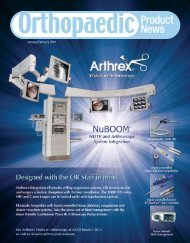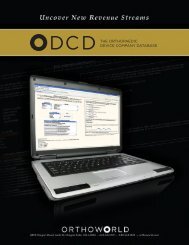Spinal Surgery, Cement Systems - Orthoworld
Spinal Surgery, Cement Systems - Orthoworld
Spinal Surgery, Cement Systems - Orthoworld
Create successful ePaper yourself
Turn your PDF publications into a flip-book with our unique Google optimized e-Paper software.
POSITION PAPER<br />
continued from page 30<br />
of health care visits for low back pain came from those under the<br />
age of 65. These visits were often accompanied by either a<br />
reduced ability to work or a complete inability to work. In fact,<br />
back pain is the most often cited issue in work or walking limitations,<br />
with some 32 percent of sufferers being limited in the<br />
amount or type of work they can do.(ibid)<br />
All told, low back pain is the most frequently cited<br />
musculoskeletal condition, with nearly 62 million adults in the<br />
U.S. reporting having it. One in two Americans experience back<br />
pain at least once a year.(ibid) Estimated direct medical costs for<br />
all spine related conditions reached $194 billion for the years<br />
2002-2004, with annual indirect costs of $14 billion in lost wages.<br />
Just $29 billion of these costs related to the cost of primary and<br />
revision spinal fusions and inpatient discectomy. Most of the<br />
cost derived from nonsurgical therapies.(ibid)<br />
Although some back procedures remain controversial, the<br />
science of spine surgery is young compared to joint replacement.<br />
However, tremendous strides have been made by the scientific,<br />
surgical and technology communities. In fact, a recent study<br />
found lumbar spine surgery outcomes and cost-to-benefit ratios<br />
to be better than or equal to other types of medical implant<br />
surgeries (e.g. joint replacement and coronary artery bypass<br />
graft surgery. 8<br />
Over the past generation, manufacturers and surgeons have<br />
brought invaluable orthopaedic technologies and treatments to<br />
the American public. We have designed and developed stainless<br />
steel and titanium plates that repair fractures that would<br />
otherwise debilitate patients and leave them bed-ridden as is the<br />
case in many third world countries today. As a result of technological<br />
advancement, these fractures go on to heal in 95 percent<br />
of cases.<br />
Moving into the future, our country will face a potential crisis.<br />
In 1960, we had 4.5 workers for every retiree. By 2040, that<br />
number will drop to 2.2 workers per retiree. 9 Today, some 140<br />
million Americans under the age of 65 work. 10 An additional six<br />
million elderly Americans are working and more and more are<br />
working full-time. 11 These 146 million Americans will experience<br />
more than two million broken bones each year. More than 80<br />
percent of them will suffer with back pain and they will incur<br />
nearly nine million soft tissue disorders and sprains and strains<br />
in a typical year. And, due simply to wear and tear of their aging<br />
joints (and old sports injuries), they will develop painful<br />
arthritis. In turn, they will need fracture repair and joint replacements,<br />
spinal disc replacement and other orthopaedic interventions<br />
to return them to an active and productive life. Denying or<br />
even diminishing this most basic and essential care would not<br />
only do perhaps irreparable harm to them, but also to the nation,<br />
by depriving it of its economic, social and spiritual engine.<br />
References<br />
1. The Burden of Musculoskeletal Diseases in the United States, 2008.<br />
2. National Center for Chronic Disease Prevention and Health<br />
Promotion, www.cdc.gov/ARTHRITIS/data_statistics/<br />
arthritis_related_statistics.htm.<br />
3. Agency for Healthcare Research and Quality, Department of<br />
Health and Human Services, hcupnet.ahrq.gov.<br />
4. Gottlob CA; et al. The Long-Term Cost-Effectiveness of Total<br />
Knee Arthroplasty for Osteoarthritis. AAOS Scientific Paper #114,<br />
Atlanta GA, February 23, 1996. (From www.onepatient.us -<br />
Figures adjusted to 2007 dollars, and represent the comparative<br />
cost of surgical vs. non-surgical treatment over the life of an<br />
average 70-year-old patient with end-stage osteoarthritis.)<br />
5. Chang RW; et al. A Cost-effective Analysis of Total Hip<br />
Arthroplasty for Osteoarthritis of the Hip. JAMA, 1996; 11: 858-865.<br />
(From www.onepatient.us - Figures adjusted to 2007 dollars,<br />
and represent the comparative cost of surgical vs. non-surgical<br />
treatment over the life of an average 60-year-old patient with endstage<br />
osteoarthritis.)<br />
6. Suarez-Almazor; et al. Gains in Quality-Adjusted Life-Years<br />
(QALYs) in patients undergoing hip or knee replacement. Int Soc<br />
Technol Assess Health Care Meet, 1999; 15:57.<br />
7. Espigares, et al. The 134th Annual Meeting & Exposition of<br />
APHA, 2006.<br />
8. Polly; et al. SF-36 Physical Component Scale (PCS) benefit/cost<br />
ratio of lumbar fusion: comparison to other surgical intervention.<br />
2005.<br />
9. Health Care Financing Administration.<br />
10. Bureau of Labor Statistics. Employment status of the civilian<br />
noninstitutional population by age, sex, and race, 2008.<br />
11. Population Reference Bureau. Full-Time Work Among Elderly<br />
Increases. 2006.<br />
The above document is purposely not copyrighted<br />
to allow any and all persons to use all or portions<br />
of it in whatever manner they see fit.<br />
September/October 2009 • ORTHOPAEDIC PRODUCT NEWS 31



